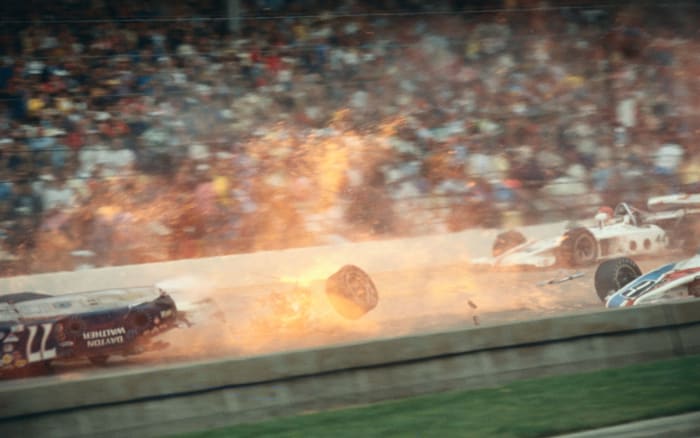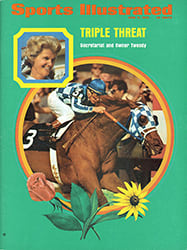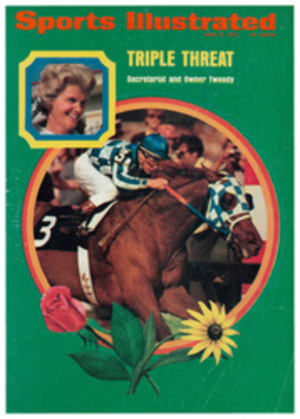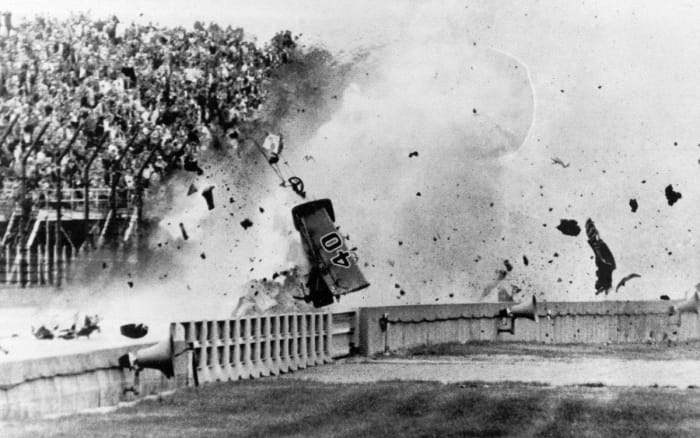Indy's Somber Trial By Fire And Rain
No doubt about it, the Indy 500 is the grandest event in sport—and the grimmest. For Memorial Day, 1973 the orchestrators of "the greatest spectacle in racing" unwittingly combined two normally antithetical elements, fire and rain, to produce a week of horror and frustration. By the time it was over the body count had reached 16, with one crewman dead, two drivers critically burned and 13 spectators hospitalized for injuries ranging from grave to merely painful. Somewhere along the way the race also produced a winner, Gordon Johncock in a red STP Eagle-Offy. But his well-earned triumph was overshadowed by the pall of destruction that surrounded it.
It was obvious last Monday that the full 500 miles could not be run that day, yet Indy officialdom is nothing if not persistent. The high winds and drenching rains that had made such a mess of the whole month of practice and qualifying seemed to have redoubled in strength on Memorial Day. Great roiling waves of rain clouds swept up from the south, soaking the just and the unjust alike, then stood aside for a few minutes as if to raise false hopes that the race might be run.
All through that long, waterlogged day the spectators waited—a third of a million miserable speed freaks, most of them wet, some of them falling-down drunk, all of them hopeful for a start. The management's customary blend of prerace activities included this year a caravan of off-white Cadillac convertibles carrying 23 ex-POWs who drew the heartiest, schmalziest applause of the afternoon. To many of the former prisoners the scenes that were soon to come would be reminiscent of a low-level bombing raid over Hanoi, replete with napalm and shrapnel.
After four hours of delay and countless laps by the track's tow trucks, whose tires helped to dry the asphalt, Speedway President Tony Hulman finally uttered the magic words, "Gentlemen, Start Your Engines," and the 33-car pack pulled put for the shortest race in Indy's 57-year history. This was the fastest field ever, averaging 192.329 mph, which came to 8.674 mph faster than was produced by last year's contingent. That speed alone had plenty of racing people nervous. The cars, with their wide wings and treadless tires, stir up turbulence and are tricky to control. The deaths of Jim Malloy and Art Pollard during qualifying practice runs last year and this had yet to be explained. Both cars had veered sharply to the right while cornering, leaving no skid marks on their way into the fatal outside wall. At speeds of some 200 mph, a car covers the length of a football field in one second. There is no "collection time," no time to react to danger when something goes wrong.
Add to those mechanical fears the fact that Indy drivers are a high-strung, hard-charging bunch to begin with, and that they had been waiting to race for most of a long, stomach-eroding day, and all the elements of tragedy were in place. The only thing required was a fouled-up start, and since there had already been four of those in the last eight years, the odds were in favor of fire on top of rain.
As the cars came past the jam-packed main-straight grandstand for the parade lap, it was evident that plenty of drivers in the rear of the pack, plus a few in the front, were assuming that this would be a sprint race. If only 101 laps were completed, rather than the customary 200, the race would be official and there would be a winner. The pack was strung out unevenly, with only the front row of pole sitter Johnny Rutherford, Bobby Unser and Mark Donohue, last year's winner, in anything resembling good order. That ragged formation did not improve on the pace lap that followed. Yet Harlan Fengler, the Indy Establishment's aged chief steward, gave the go-ahead to pace car driver Jim Rathmann to pull off. Pat Vidan, the elderly acrobat of the starting platform, did his dance with the green flag and the race was on...
...and off again just a few hundred feet farther down the track. In the sixth row the youngest driver in the field, David (Salt) Walther, age 25, suddenly veered sharply to the right—nobody knows exactly why. He climbed the left front wheel of another car and smashed into the wall and the wire debris fence. His car exploded in an orange fireball, spewing flames and metal into the crowd that stood wide-eyed just a few feet from the wall. The volatile methanol fuel—75 gallons of it—gushed forth and flared like a flamethrower as Walther's car bounced back onto the track, pinwheeling down through the onrushing pack like some kind of fiery new weapon of war. In a display of reactive driving unparalleled in Indy history, most of the 17 cars running with or behind Walther managed to avoid the spinning wreck. Those that hit it did so with glancing blows.
The front of Walther's car was clipped off by the impact as neatly as if by a can opener. That probably saved his life, for it ruptured the fuel bladder, and the centrifugal force of the spin then emptied the methanol before it could incinerate the driver. "If it had been confined to the car," said a teammate later, "he would have been cooked like a marshmallow."
As it was, Walther lay upside down in the coffinlike tub with his feet protruding during most of the spin and for long moments after it came to rest, flames licking his legs, body and face. He was conscious when the rescue squad finally cut him loose, and there had been no flame inhalation of the sort that killed Art Pollard two weeks earlier. Still, Walther suffered third-degree burns over 25% of his body. Twelve cars were damaged in the wreck, but the other drivers suffered only minor injuries at worst.
Nonetheless, there was outrage. "These are supposedly the best drivers in the world," said England's David Hobbs, who had flanked Walther on the grid and escaped the horror only by instant reflex, "yet they can't even make it down the bloody straightaway!"
Mike Mosley, who has crashed four times in the last three races, leaped out of his wrecked machine and charged Starter Vidan, cursing him for a blunderer. Mike Hiss, 1972's rookie of the year, described the start quite simply: "Ridiculous." As for the fans in the grandstand, 13 of whom were burned and bashed by the wreckage, the only statement was a cacophony of screams and moans. Most of the injured spectators suffered corneal burns. Two teen-age girls were listed in critical condition.
The Walther accident brought out the red flag, and a short while later the rains returned in earnest, postponing the race. On Tuesday the rains continued, aborting another start, but by midafternoon on Wednesday the track was dry enough to give it another try. By now, the original crowd of 350,000 had been reduced to less than half that number, diehards all. For the third time in as many days, Tony Hulman told the gentlemen to do their thing, but by now the words had taken on an ominous valence.
The start, at least, was trouble-free. Bobby Unser dove into the first turn with the hardboiled élan for which he is infamous, followed by Mark Donohue. Johnny Rutherford flubbed a gear change and thus lost the pole advantage as wondrously as he had won it. But almost immediately there were casualties. The engine of Bobby Allison's Sunoco-DX Special let go on the second lap and the stock-car star retired in a miasma of blue smoke. On the fourth lap, with the track very slippery, Peter Revson went wide in Turn Four, lost control and skidded into the inside retaining wall. He was not hurt, but his orange Gulf McLaren was finished—and the shape of the tragedy to come had been lightly sketched on the slick banking of Turn Four.
Other top drivers went out during the first hour, among them Mario Andretti, with a burned piston, and A. J. Foyt, who quickly commandeered the car of his teammate, George Snider, thus drawing boos from the crowd for the first time in his Indy career. By the 42nd lap the lead belonged to Swede Savage, the hard-charging 26-year-old from Santa Ana, Calif. who had made a remarkable comeback from his near-fatal crash at Ontario two years ago. His Day-Glo red STP Eagle, prepared by master mechanic George Bignotti, was running perfectly, as were the cars of his teammates, John-cock and New Zealander Graham McRae. His pit stops had been super-quick, and Savage had every reason to believe that he could win. Then, on the 59th lap, having relinquished the lead during a refueling stop to Al Unser's Viceroy Special, Savage came charging into Turn Four to produce the most spectacular crash of the week.
At the apex of the turn his rear wheels apparently came unstuck from the oil-drenched groove. Bobby Unser, coming up behind, saw Savage bobble and braced for disaster. "It seemed like he almost got back under control," Bobby said later, "but then down he went." Straight down the banking, across the infield grass, and virtually head-on into the retaining wall. The car, ripped in half by the impact, exploded in a gout of blazing methanol with the engine spinning one way and the monocoque tub another. Tires flew skyward through the flames, along with bits of steel and a shower of Day-Glo red paint flakes. Before the explosion, Savage punched the button of his radio transmitter and yelled to his crew: "Holy Christ! What a mess!"
Skidding and flaring, the tub shot back out across the track and came to rest near the outside wall. Savage seemed unable to unhook his safety harness, but he surged against the straps again and again as the flames surrounded him. Finally the rescue crew reached him. He was conscious and almost cocky in the ambulance, but both of his legs were badly broken, bent up almost into his groin. His eyes appeared to be glued shut, and his hair was singed. Yet he had not breathed the flames, and his new, two-layer "foam suit," which can keep a man alive for a full minute in the hottest fire, had probably saved him.
But nothing could have saved the life of STP Crewman Armando Teran, who was standing in the pits with Crew Chief Vince Granatelli when Savage crashed. Teran, 22, asked Granatelli if he should run up to Turn Four and help with the wrecked car. "I told him "yeah,' " Vince said later, "and he ran out into the pit road, looking north toward the fire." Also heading north at 50 or 60 miles an hour—against the normal flow of traffic—was a fire truck. The truck blindsided Teran, knocking him 50 feet up the pit road. The impact bent the bumper into a shallow V. His ribs crushed and his skull broken, Teran died an hour later at Methodist Hospital.
The race was stopped for 84 minutes as a result of the twin tragedies, when it resumed, no one had much heart left for thrills and spills. Johncock took the lead from Al Unser on the 73rd lap and just kept trucking. Wee Gordy, who stands only 5'7" and who normally sports one of the gaudiest grins in racing, fought off a challenge from Billy Vukovich and maintained a safe lead of about 25 seconds through the remainder of the race. The skies were once again glowering, and by the 130th lap the first raindrops splattered their familiar sound on the back straightaway. The yellow flag came out, and three laps later the red. The race ended officially at 133 laps—332.5 miles—and without the usual ebullience of a checkered flag. Johncock was subdued in victory, allowing that perhaps the cars should be slowed down in the future. Even sponsor Andy Granatelli was remarkably restrained. There were no kisses this time, no drenchings with champagne. "I'm happy for Gordy, of course," said Granatelli, "but this has been an ugly day."
And then the rains came once again.
TWO
PHOTOS
Swerving right, Salt Walther's car slashes explosively against the fence.
PHOTO
Between brief bouts of racing, Indy's faithful sit patiently through the lost weekend.
PHOTO
Scattering fire and injuries in its path, the demolished racer spins down the main straightaway while other drivers seek to snake past.
PHOTO
Firemen work as track medics move to lift Swede Savage out of wreck and onto stretcher.
PHOTO
Survivor rather than winner, Gordon Johncock rolls toward victory—after only 332.5 miles.
PHOTO
With no checkered flag, a kiss sealed the win.



